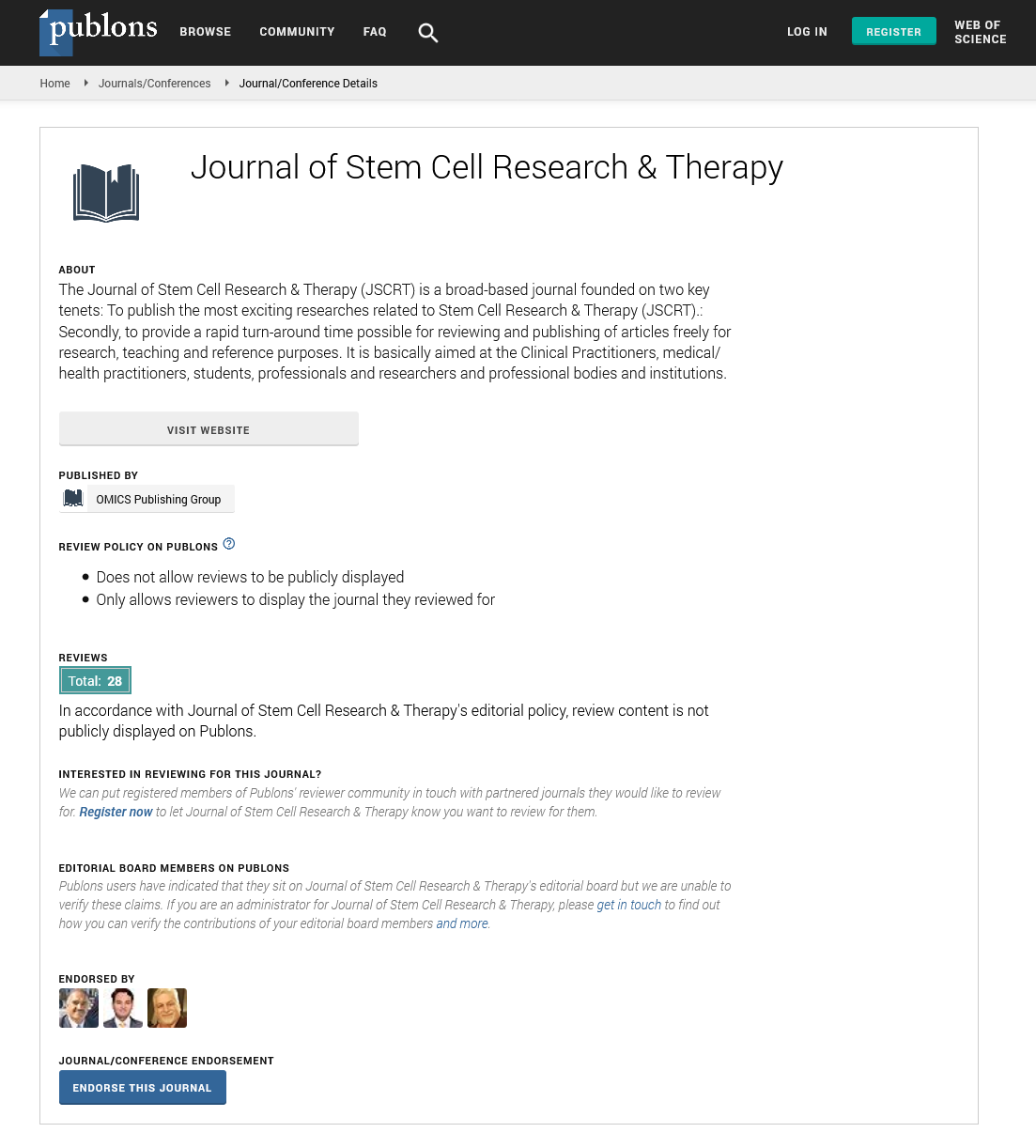Indexed In
- Open J Gate
- Genamics JournalSeek
- Academic Keys
- JournalTOCs
- China National Knowledge Infrastructure (CNKI)
- Ulrich's Periodicals Directory
- RefSeek
- Hamdard University
- EBSCO A-Z
- Directory of Abstract Indexing for Journals
- OCLC- WorldCat
- Publons
- Geneva Foundation for Medical Education and Research
- Euro Pub
- Google Scholar
Useful Links
Share This Page
Journal Flyer

Open Access Journals
- Agri and Aquaculture
- Biochemistry
- Bioinformatics & Systems Biology
- Business & Management
- Chemistry
- Clinical Sciences
- Engineering
- Food & Nutrition
- General Science
- Genetics & Molecular Biology
- Immunology & Microbiology
- Medical Sciences
- Neuroscience & Psychology
- Nursing & Health Care
- Pharmaceutical Sciences
Perspective - (2022) Volume 12, Issue 10
Importance of Fetal and Somatic Stem Cells and their Physiological Characteristics
Shang Li*Received: 03-Oct-2022, Manuscript No. JSCRT-22-18663; Editor assigned: 06-Oct-2022, Pre QC No. JSCRT-22-18663 (PQ); Reviewed: 20-Oct-2022, QC No. JSCRT-22-18663; Revised: 27-Oct-2022, Manuscript No. JSCRT-22-18663 (R); Published: 03-Nov-2022, DOI: 10.35248/2157-7633.22.12.561
Description
Undifferentiated cells known as stem cells have the ability to selfrenew, as well as to proliferate in undifferentiated cells and develop into mature specialized cells. The use of stem/ progenitor cells to cure cancer, degenerative disorders, and other illnesses, as well as to replace lost or damaged tissues, is the subject of numerous clinical trials that are currently underway. These teratocarcinoma stem cells, which can be thought of as the cancerous equivalents of embryonic stem cells that come from the inner cell mass of a blastocyst stage embryo, are known as embryonic carcinoma cells. Under the conditions of cell culture, the embryonic carcinoma cells multiply and expand. Pluripotent cells called Embryonic Stem Cells (ESCs) have the capacity to develop into cells from each of the three germ layers (endoderm, mesoderm, and ectoderm). Teratoma development is the most used test for proving pluripotency. Pluripotent stem cell lines must, however, be able to meet a number of additional requirements. Stem cell lines can proliferate forever, express ESC markers, and have morphology that is similar to that of ESCs. Additionally, the cell line creates teratoma and embryonic bodies with all three germ layers. When injected into early blastocysts in mice, pluripotent stem cells have the ability to create chimaeras.
Induced pluripotent stem cells, a non-pluripotent adult differentiated somatic cell is used to create Induced Pluripotent Stem Cells (iPSCs), a form of pluripotent stem cell. First, "forced" expression of particular genes was used to convert an adult somatic cell into an induced pluripotent stem cell (iPSC). The forced expression of a specified set of transcription factors (Oct4, Sox2, c-Myc, Klf4, Nanog, and Lin has been shown to be capable of reprograming human and mouse somatic cells into iPSCs at this time. There are currently many documented alternate methods for producing iPSC; these will be included in this paper's section on genetic alteration. The majority of fibroblasts are used in the creation of iPSCs, however mature B cells, pancreatic b cells, and liver have also been used. The similarities between ESC and iPSC outweigh the differences in their origin. They share a great deal of the same developmental potential, epigenetic alterations, and gene expression profiles.
Somatic stem cells, differentiated tissues include multipotent Somatic Stem Cells (SSCs), also known as adult stem cells. By replenishing lost cells, these cells naturally maintain and regenerate ageing or damaged tissue. In general, both juvenile and adult animals as well as humans have these undifferentiated cells everywhere over their bodies. Depending on their shape, cell surface markers, propensity for differentiation and tissue of origin, SSC can be categorised into various groups. Examples include endothelial progenitor cells, mesenchymal stem/stromal cells and Hemopoietic Stem Cells (HSC) (EPS). The ability of somatic or adult stem cells to divide or self-renew indefinitely and (with certain restrictions) differentiate to produce all the specialised cell types of the tissue from which they originated has attracted the attention of scientists. For instance, neural stem cells are self-renewing multipotent cells that primarily produce nervous system phenotypes (such as neurons, astrocytes, and oligodendrocytes). These cells are crucial to neurogenesis. Although in theory SSC can be obtained from a variety of tissues, cord blood and bone marrow are two sources that are frequently employed as SSC sources for stem cell therapy.
Fetal stem cells, the group of Fetal Stem Cells (FSC), which can come from either the fetus or from additional embryonic tissues of fetal origin, includes a relatively new form of stem cell. Teratomas are not created by fetal stem cells. Based on the tissues from which they originate (such as amniotic fluid, umbilical cord, Wharton's jelly, amniotic membrane, and placenta), different subtypes of fetal stem cells have been identified. Fetal stem cells are excellent sources for regenerative therapy because of their high multiplication rate and relatively simple accessibility. Given their characteristics, foetal stem cells can be viewed as a functional and developmental intermediary between ESCs and SSCs. Mesenchymal Stem Cells MSCs were used in the first adult stem/progenitor cell clinical studies to repair non-hematopoietic tissues. Patients with osteogenesis imperfecta and those with mucopolysaccharidoses were the subjects of the early clinical trials using MSCs. Clinical trials using SSC have also been started for the following indications: suppression of severe GVHD autoimmune diseases, skeletal tissue repair, amyotrophic lateral sclerosis, chronic spinal cord injury, chronic wounds that don't heal, vascular disease, coronary artery disease, and myocardial infarction. Patients with cardiac disease who also have MSC are currently the subject of the most clinical trials. MSC, which were frequently obtained from bone marrow, were employed in the majority of clinical trials looking at stem cell therapy.
Citation: Li Shang (2022) Importance of Fetal and Somatic Stem Cells and their Physiological Characteristics. J Stem Cell Res Ther. 12:561.
Copyright: © 2022 Li Shang. This is an open access article distributed under the terms of the Creative Commons Attribution License, which permits unrestricted use, distribution, and reproduction in any medium, provided the original author and source are credited.

